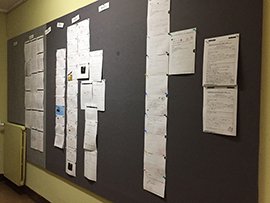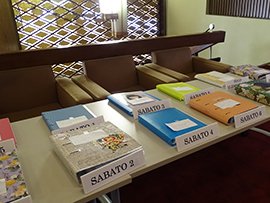Creating an Environment Conducive to Continued Japanese Learning
The Japan Cultural Institute in Rome
TSURUTA Yasuyuki
The Japan Cultural Institute in Rome was the first cultural institute established by the Japanese government overseas in 1962. The Institute is located in a quiet scholastic district that is home to the Borghese Park, the National Gallery of Modern and Contemporary Art, and cultural facilities from numerous other countries. The Japanese-language course (hereinafter “JF course”) was launched in 1964, and the Institute has continued to provide the course as an opportunity for the people of Italy to learn the Japanese language over the half century since that time. Students range in age group from the teens to 80s and come from a variety of occupations. Many of them started learning the Japanese language on their own initiative out of an interest in such topics as Anime, Manga, travel to Japan, traditional Japanese culture, or the Japanese language itself. Accordingly, the JF course is carefully designed with continuing education in mind, through various methods, so that the learners can enjoy interacting with the Japanese language over the long term, rather than simply aiming for language mastery alone.
Making Classrooms Pleasant by Producing and Sharing Learning Achievements
A great deal of time is required for Italians to learn Japanese language due to the significant differences between the languages, and many learners give up half way. Therefore, I feel it is important to encourage more active communications during class and make the classroom a pleasant and comfortable place through producing and sharing learning achievements so that the students continue enjoying learning over the long term. For example, since most Italians love to talk and communicate, I try to have students speak and write about themselves (personalization) during writing and conversation practice in the classroom, with reference to examples in the textbook. The completed writings are then shared on the walls in the hallway. If the students can learn about their classmates through those writings and develop an interest in each other, it will lead to an atmosphere of mutual support, and make the classroom a more pleasant place. They can also start to envision how they will be able to express themselves next by reading the texts of higher level students. I feel that through these measures, the students will have the will to continue studying without giving up even when they might run into trouble.
We also emphasize Portfolio activities in the JF course. The Portfolios are used for students to record and keep their own progress and achievements, and the students at the Institute keep records such as the “Can-do Checklist,” “Learning Achievements,” and a “Diary of Cultural Experiences.” Up until fiscal 2018, we used a competitive approach in order to promote the use of the Portfolios, but since we have now achieved that goal to some extent, we switched to the approach of putting the Portfolios on display for reference by other students at the end of the semester in fiscal 2019. The Portfolio exhibit apparently provides a great stimulus for both the students who made them and the students who view them.

Student writings on display.

The Portfolio exhibit.
From Teacher to Communicator
I have begun hosting an event called Suki wo Share Shiamo, or Share your likes, where iamo in Italian has the same meaning as Shimasho (let’s do) in Japanese. The purpose of the event is to build a place for students to communicate each other through Japanese and for the students to develop relationships with each other beyond the classroom boundary through shared hobbies and interests. The event involves each student giving a presentation on things they like or are interested in. In fiscal 2019, three students gave presentations on such topics as “Japanese idol groups,” “Judo,” and “knitted plush toys,” while other students interested in those themes participated as the audience. The presentations were followed by energetic question and answer sessions, and when they were over, I could see on the faces of the students the satisfaction over having shared something they enjoy and the sense of achievement for having made it through the presentation.
I also launched a new event called “Japanese Language Reading Group Circle (Circolo di lettura in lingua)” with the cooperation of the librarian at the Institute’s library. This event involves discussions in Japanese on different books each time that the participants read beforehand, where the participants include both non-native Japanese speakers at the intermediate and advanced level and native Japanese speakers who are interested in literature. While the Covid-19 pandemic struck after having hosted the event at the Institute two times, making further face to face meetings difficult, I intend to continue the event online moving forward.
In recent years, there has been a trend of moving starter and elementary classes for the JF course online throughout the world, but I feel that the learning support that can be provided in face to face classes, and the cultivation of friendship between students, is important for helping the students to get their studies on track at these levels. If students are able to learn face to face the fundamentals of the Japanese language and to build relationships through that Japanese at those levels, I believe they will be able to maintain their motivation whether subsequent classes are online or face to face, so they should be free to learn in whichever way they like at their own pace.
The Institute also holds other events, such as the “Japanese Tadoku Reading Group” (using the Tadoku reading method of extensively reading short texts quickly) and “Wai Wai Shaberi Amo” (the Japanese Language Conversation Group), and one common factor to both events is that there is no separation between the teachers and learners. Equal communications will not occur within the unbalanced relationship of the teachers and the learners. When we think of “autonomous learning”, we typically think of learning at your own pace by setting your own learning goals and plans. However, I believe another important factor for autonomous learning is for the student to change from the passive position of being taught to someone with the active ability to produce output by themselves. The Institute will continue to focus on building an environment conducive to continued learning of the Japanese language, and provide assistance so that as many students as possible may enrich their daily lives through the Japanese language.
- What We Do Top
- Arts and Cultural Exchange [Culture]
- Japanese-Language Education Overseas [Language]
- Japanese-Language Education Overseas [Language] Top
- Learn Japanese-language
- Teach Japanese-language
- Take Japanese-Language Test
- Know about Japanese-language education abroad
- The Japanese-Language Institute, Urawa
- The Japanese-Language Institute, Kansai
- Japanese-Language Programs for Foreign Specified Skilled Worker Candidates
- Japanese Language Education for Japanese Children Resident Overseas and for the Descendants of Migrants
- Archives
- Japanese Studies and Global Partnerships [Dialogue]
- JF digital collection
- Other Programs / Programs to Commemorate Exchange Year
- Awards and Prizes
- Publications
